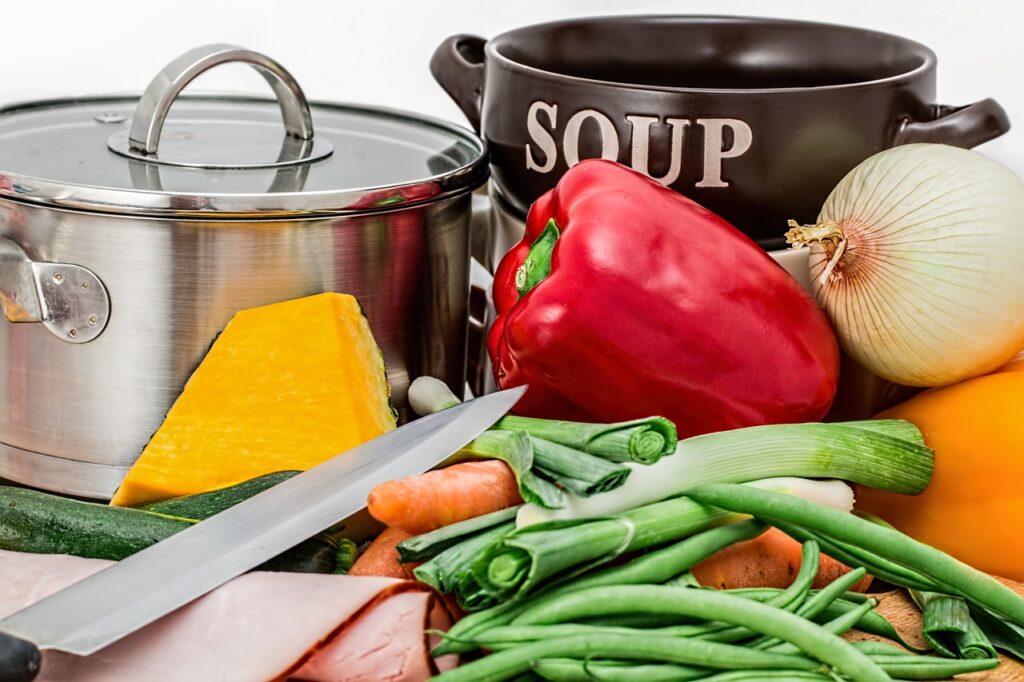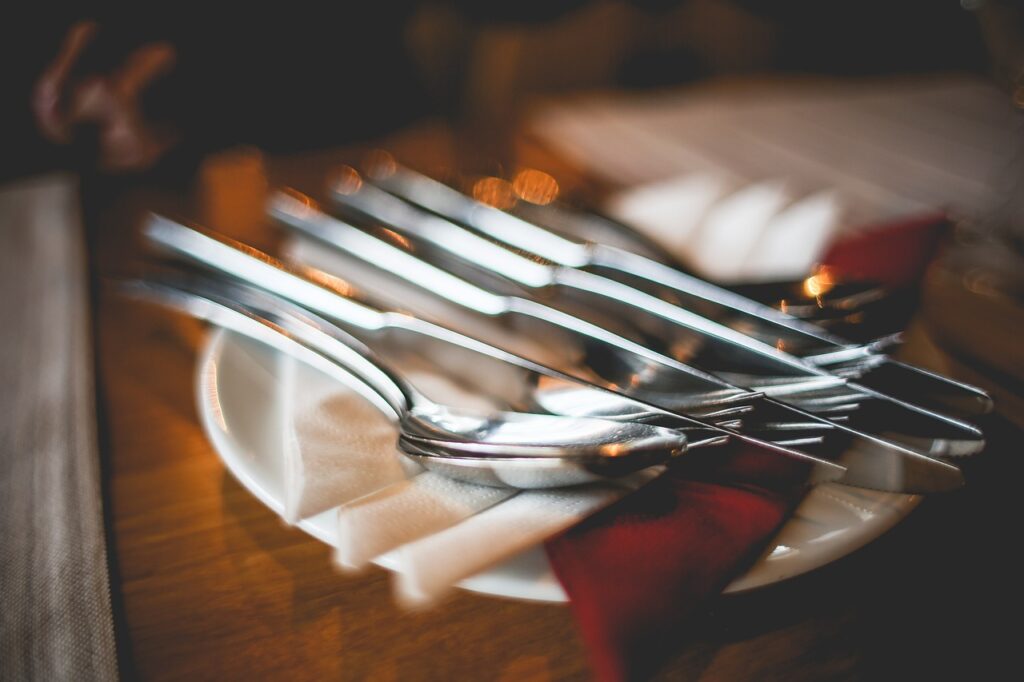Non-Toxic Cookware: Have Chemicals Been Lurking in Your Food?
Are chemicals leaching into your scrumptious meals just because of the kinds of cookware you’re using?
Have you ever wondered if the cookware you regularly use to cook the stuff that goes into your body every day is actually safe?
If you haven’t ensured that the cookware you’re using is safe, there’s a good chance that chemicals are lurking in every meal you consume.
- Benefits of Using Non-Toxic Cookware
- Cookware to Avoid
- Non-Toxic Cookware Recommendations
- Conclusion
- Non-Toxic Cookware FAQs
- What chemicals are found in conventional non-stick cookware?
- How does toxic cookware impact health?
- What are the safest, non-toxic cookware options?
- Are there truly non-toxic, non-stick options?
- Should I throw out my old Teflon pans?
- How can I prevent exposure to toxins from cookware?
- Are non-stick pans safe if not overheated?
- How do I know if cookware is truly non-toxic?
If you love your non-stick Teflon-coated pan, you probably never heard of “Teflon flu,” aka Polymer fume fever, or else you wouldn’t be using it.
Well, you might want to look at your cookware again and re-evaluate. You definitely want to do enough research to be certain that your cookware is safe to use in every respect of the word.
This page will assist you in researching various types of cookware to find out which is safe for you and your family. Read further to know more about non-toxic cookware, what to look for, various types, and the benefits of using this safer cookware.
Benefits of Using Non-Toxic Cookware
The major issue of traditional cookware, including non-stick pans and aluminum, is that it often contains chemicals that may leach into food quite easily. Most of us presume that the pots and pans we cook with are safe without question. No one would want chemicals leaching into their food or into the food of the ones they love.
The good news is that non-toxic cookware that won’t leech chemicals into the food is available. This safer cookware is readily available for purchase for those of you who have no interest in eating contaminated meals. Most of these safer cookware alternatives are more simple, old-fashioned, and a lot more fun to cook with.
Non-toxic cookware is often less expensive compared to harmful Teflon cookware and other chemically non-stick varieties, but not always. Most non-toxic cookware is also dishwasher safe, oven safe, able to be used on the stove-top, and easily washed. Not only is this safer cookware easy to use and handle, but it also performs better when cooking.
Safe, non-chemical leaching cookware comes in all kinds of shapes and sizes. In a bit, we’ll show you the best kinds of safe cookware to purchase. But first, let’s take a look at the kinds of cookware you need to avoid.
Cookware to Avoid
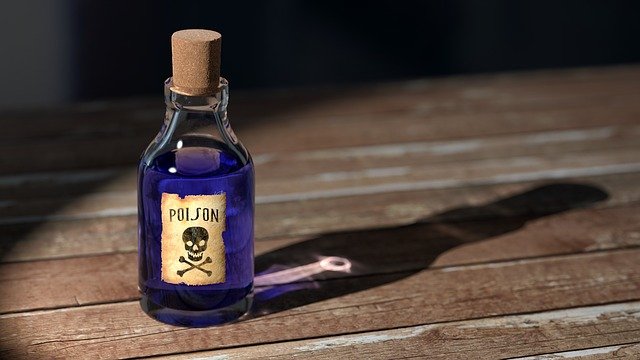
Teflon
We’ve all heard of Teflon, which is short for Polytetrafluoroethylene (PTFE). We even see the incidence of this synthetic fluorocarbon fluoropolymer in bathroom cleaning products due to its ability to create a slick, non-stick surface.
Though the benefits of this synthetic compound have been touted repeatedly, there’s a rather large elephant in the room that most big companies don’t want you to think about. The elephant in the room that a lot of people don’t want to think about can be addressed by asking a simple question.
Here’s the Question:
Is Teflon Safe?
Teflon has been proven to emit fumes at high temperatures that are harmful to humans. These fumes that can be inadvertently created under normal conditions have even been known to kill pet birds.
Actually, one expert who studied “Teflon Toxicosis” as early as 1986 claimed that this condition was the leading cause of death among birds. There have been cases where birds have died within minutes! I don’t know about you, but I’d rather not breathe in fumes that kill birds almost instantly.
If heating up my cookware causes it to release fumes that would kill pet birds almost instantly, it’s probably time to switch to something safer. I’d also rather not expose babies, children, or any of my loved ones to those fumes.
In Humans, Teflon is not without its health consequences. At the beginning of this article, “Teflon Flu” was mentioned, also known as Polymer fume fever. When Teflon is heated to high temperatures, it releases toxic fumes. When you breathe these fumes, you will develop flu-like symptoms. The long-term effects of regular exposure to Teflon fumes are unknown because studies are lacking and inadequate.
While manufacturers provide warnings on their labels recommending avoiding high temperatures with their products, it’s been demonstrated that these fumes can occur in as little as 2-5 minutes on a conventional stovetop. So, while I’m sure we appreciate the warnings, they don’t really help!
The associations between Teflon chemicals and adverse health effects are somewhat controversial, but DuPont and 3M were forced to stop their way of producing the chemical as of 2015 to prevent it from being released into the environment. However, even though production has changed and other chemicals are being used, those chemicals are very similar and pose the same risks.
See a recent news story where DuPont was ordered to pay 5.1 million dollars to a man who worked in one of its Teflon Plants: “Dupont Ordered to pay $5.1M in Testicular Cancer Case“.
For further reading, check out the “Madrid Statement“, a document signed by over 200 scientists from over 38 countries, highlighting the dangers of both the old and new chemicals, as well as their use in various household products.
Teflon Dangers – A Short List:
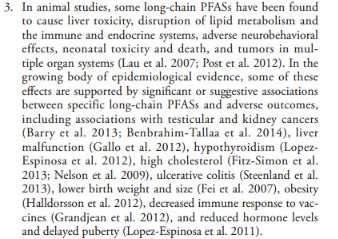
- Liver Toxicity
- Neonatal Toxicity
- High Cholesterol
- Ulcerative Colitis
- Decreased Birth Weight
- Decreased Vaccine Immune Response
- Delayed Puberty
- Reduced Hormone Levels
- Tumors
Besides the dangers listed above, other potential adverse health concerns have been noted by many. Avoid Teflon.
Aluminum
It’s said that aluminum damages brain tissue. Perhaps that’s one reason that there have been studies linking aluminum exposure to an increased risk of Alzheimer’s disease. Actually, it’s said that aluminum exposure may be the “single most aggravating and avoidable factor related to AD [Alzheimer’s Disease].”
All things considered, you should limit your exposure to aluminum if possible. It’s great that aluminum is so light, inexpensive, heats quickly, and is easy to clean, but do you really want to take an unnecessary risk?
A family relative of ours has Alzheimer’s Disease, and she’s been cooking with aluminum pots and pans all her life. While there’s no intention of postulating that as scientific evidence of a direct link (correlation does not always equal causation), studies have shown incriminating evidence about the potential dangers of aluminum.
It’s just not worth the risk. Stop cooking with aluminum leaching pots and pans because there are far better and safer alternatives.
Copper
Who doesn’t like the glimmer and shine of copper? Copper cookware is beautiful and performs quite well for novice and professional cooks alike. That being said, not all things beautiful are things that should be used. If you have copper cookware, use it rarely because it really belongs on the shelf.
The finish of copper cookware is primarily made up of copper and nickel, both of which are heavy metals. These heavy metals are then leached into food during cooking and can build up in the body over time.
If you do use copper cooking equipment, be sure it’s encased in a non-toxic material like stainless steel. Do not use copper-lined cookware.
Non-Toxic Cookware Recommendations
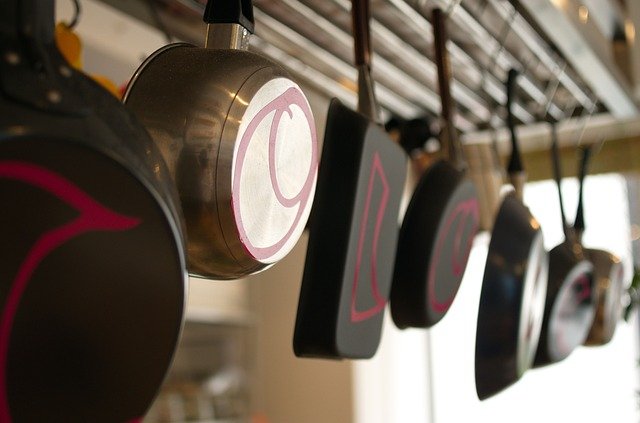
Once you begin cooking with non-toxic cookware, you’ll see that there’s absolutely no reason to continue cooking with cookware that poses the risk of chemicals leaching into food. Once you understand more about the simplicity and price accessibility of non-toxic cookware, you’ll see how easy it is to replace your chemical-leaching pots and pans with safer alternatives.
Better yet, you’ll actually recognize the materials that this safer cookware is made from.
Ceramic
Ceramic is generally safe as long as you do your due diligence before purchasing. One problem with ceramics, in general, is that many companies use cheap manufacturing methods and materials from foreign countries. If cheap ceramic cookware is produced in a foreign country, there’s a real danger that it could contain traces of lead in the glaze.
Ceramic cookware can also break very easily, depending on the quality. Depending on the durability of some ceramic cookware, it may or may not be scratched or cracked under intense heat.
While ceramic cookware can potentially be a great alternative to the more toxic kinds of cookware mentioned earlier, the buyer must do their due diligence before purchasing.
Stainless Steel
While there are some concerns with Stainless Steel, it’s a superior choice to any of the unsafe materials we mentioned earlier, and it’s considered non-reactive. Furthermore, stainless steel is affordable and quite pleasant looking. If purchasing stainless steel, just make sure that it is actually stainless steel.
You can test the quality of your stainless steel by boiling a few tablespoons of vinegar in a stainless steel pot. While your vinegar is boiling, also pour some vinegar into a cup as your control. If the boiled vinegar tastes metallic (compared to the control), that means that your stainless steel is of lower quality and will likely leach chemicals when cooking acidic foods. In this case, don’t cook acidic foods in your stainless steel cookware.
One downside with stainless steel is that it’s not very non-stick. However, a few simple cooking hacks, like the mercury ball test, can make cooking with stainless steel much easier. Additionally, using oil or a bit of extra water is helpful when sauteeing. While your eggs may not be perfect every time in your stainless steel cookware, they’ll be safer to eat.
Most chefs believe that stainless steel browns a variety of foods much better than their non-stick counterparts. So, go ahead and brown up some stir fry or potatoes on stainless steel instead of other unsafe non-stick alternatives.
Cast Iron
A thing of the past for many, cast iron has been used for centuries. If you have old cast iron pans lying around that are not being used, it’s time to dust them off and get them ready to cook your favorite dishes. Our family loves using cast iron for a number of reasons, but the durability of cast iron is reason number one.
It’s almost impossible to damage a cast iron pan, and they last almost forever. Cast Iron is simplicity at its best.
When purchasing a cast iron pan, you’ll see there are many options. Regardless of what kind of cast iron pan you purchase, just make sure you season it if it’s not already seasoned. Properly seasoning your cast iron pan will make it mostly non-stick. Also, cast iron can go on the stovetop and in the oven, making it versatile.
Besides the quality of being seasoned, there’s a more important factor when it comes to purchasing a cast iron pan if you’re looking for something non-stick. The most important factor to consider if a non-stick surface is important to you is that the pan has been ground and polished on the inside cooking surface. The higher the polishing quality, the more non-stick it will be.
Back in the old days, cast iron pans were actually more non-stick than most you can buy in stores today because they were polished to a smooth surface. I have a very old cast iron pan that is consistently more non-stick than any Teflon-coated non-stick pan I’ve ever used.
The reason? It’s been polished to a finely smoothed surface on the inside. And when I say non-stick, I’m talking about cooking a fried egg, and it does not stick at all. Of course, the pan is also very well-seasoned.
Cast iron cookware is relatively cheap. But, if it’s not ground and polished well, food may stick to it even if it’s well-seasoned.
Enameled Cast Iron
Having the same benefits as cast iron and then some, enameled cast iron is a superior kind of cookware. While the price of quality enameled cast iron cookware is definitely higher than its basic cast-iron counterpart, it’s well worth the price.
The surface of enameled cast iron is extremely easy to cook with and doesn’t require seasoning like plain cast iron. It’s also dishwasher safe like cast iron, but far more attractive. Like cast iron, this type of cookware lasts forever.
Better yet, some companies like Le Creuset even boast long-duration warranties, lifetime warranties for some products. So, when looking for a non-stick, beautiful, and durable alternative to sub-par cookware, you can’t go wrong with enameled cast iron. If the priceyness is a negative for you, remember that you’ll likely never need to spend money on cookware again.
Conclusion
There are as many kinds of cookware as there are crayons in a crayon box! But, when it comes to choosing safe cookware, it is important to consider the materials when buying. Choosing safe cookware options is one of the simplest and easiest decisions you can make to put healthy food on the table in your home. There’s simply no excuse to use dangerous cookware.
Whether you’re on a budget, have plenty of cash to spend, or are a world-class chef, there’s safe cookware out there that will fit whatever needs you could possibly have. Do not cut corners here; don’t use questionable cookware that leaches unnecessary chemicals into your food.
Now that you know more about the toxicity and possible hazards of traditional and/or non-stick cookware, it is time to take action. Opt for safer, non-toxic cookware to save your family from toxic substances. The safe options will cook your food just as well or far better than “quality” chemical-leaching pots and pans.
Once you purchase safe cookware, you’ll be at peace with every tasty morsel of food you eat, knowing that you made a health-conscious decision to ensure your food is safe. Don’t worry; there’s still a home for your toxic cookware in the recycling bin.
Non-Toxic Cookware FAQs
What chemicals are found in conventional non-stick cookware?
Teflon non-stick pans contain PTFE and PFOA, which can release toxic fumes and chemicals when overheated.
How does toxic cookware impact health?
The chemicals released can cause flu-like symptoms and potentially other long-term health issues.
What are the safest, non-toxic cookware options?
Cast iron, stainless steel, ceramic, glass, and enamel-coated cast iron are all good non-toxic alternatives.
Are there truly non-toxic, non-stick options?
100% ceramic non-stick pans are safe and effective. That said, keep in mind that they aren’t typically very durable, and you’ll likely need to replace them after a few years. Instead, try cast iron, enameled cast iron, or stainless steel.
When using proper cooking techniques, non-stick as a preference becomes less important.
Should I throw out my old Teflon pans?
It’s best to replace worn or scratched Teflon with new, non-toxic cookware when possible. Avoid overheating Teflon.
How can I prevent exposure to toxins from cookware?
Use lower heat for non-stick pans, ventilate your kitchen, and don’t preheat empty non-stick pans.
Are non-stick pans safe if not overheated?
Small amounts of chemicals can still leach out even at lower temps. Non-toxic alternatives are safer.
How do I know if cookware is truly non-toxic?
Look for third-party tested products made of safe materials like stainless steel and cast iron.
